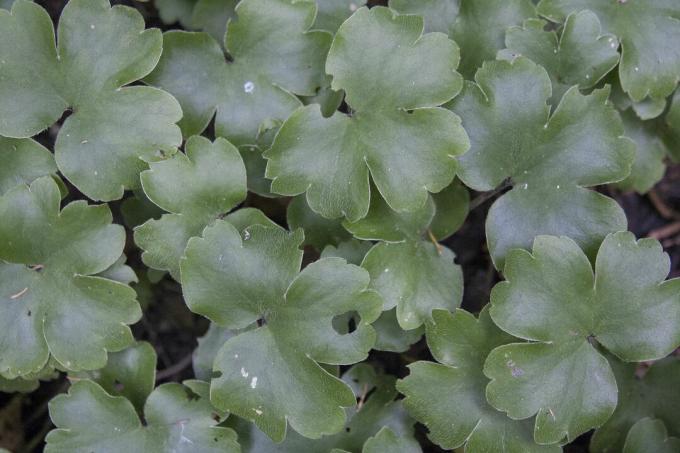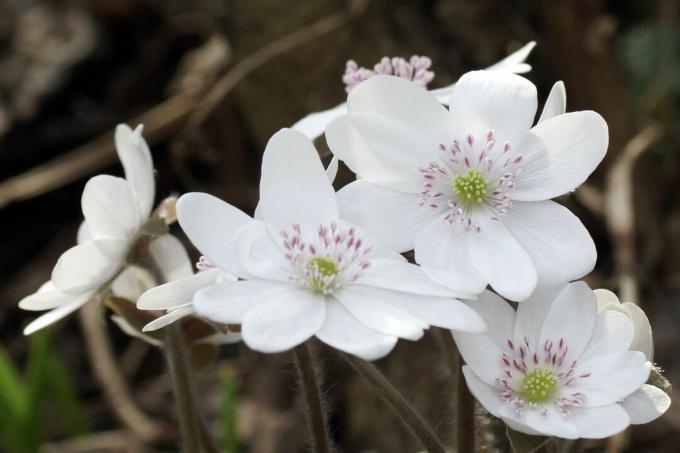The liverwort catches the eye with its blue flowers in the still barren spring landscape. We present the most beautiful varieties and give tips on location and care.

In addition to the common liverwort (Hepatica nobilis) there are other types and varieties in a wide variety of colors. We will briefly introduce you to the most beautiful variants and show you what should be considered when caring for liverworts.
"Contents"
- Hepatica profile: flowering time, origin and properties
- The most beautiful liverwort species and varieties
- Plant liverworts: location, soil and Co.
-
Hepatica care: this must be taken into account
- Water the liverwort properly
- Fertilize liverworts
- Cut and hibernate
- Propagate liverworts
- Are liverworts poisonous?
- Effect and use
Hepatica profile: flowering time, origin and properties
The Hepatica (Hepatica) belong to the buttercup family (Ranunculaceae) and are widespread throughout Europe. As is typical for all buttercups, the liverwort is slightly poisonous. In the past the plant was assigned to the genus anemones, at that time it was also known as
Anemone hepatica known. Nowadays, however, that name is no longer valid.The liverworts bloom from mid-February to April and are therefore among the early bloomers that sprout out of the ground when many other plants are still in their hibernation. Like most early bloomers, including the well-known wood anemone (Anemone nemorosa) heard, the liverwort is a spring geophyte. As such, it has underground renewal buds, with the help of which it sprouts immediately after the cold season, when enough light still falls on the ground through the bare trees.

The liverworts, up to 15 cm high, are mostly found in light deciduous forests on chalky subsoil, but the small perennial is also becoming increasingly popular in the garden. The petals shine blue-violet and are a real eye-catcher together with the white-red stamens. Some varieties also bloom white or pink. If the liverwort reproduces by self-sowing, veritable carpets of flowers can arise. Liverworts not only delight us humans, but also numerous insects that can use their pollen.
The most beautiful liverwort species and varieties
In addition to the common or three-lobed liverwort (Hepatica nobilis) and the Transylvanian liverwort (Hepatica transsilvanica) there are still a few liverwort varieties and sorts in different colors, but not all of them are used in horticulture.
Hepatica nobilis: The common liverwort, which can also be found in some light deciduous forests, blooms blue-violet, rarely pink or white. It has five to ten petals, but usually six. The leaves are entire and three-lobed.

Hepatica transsilvanica: In contrast to the common liverwort, the Transylvanian liverwort has a notched leaf margin. The stamens are also blue. This species is particularly widespread in Romania and cannot be found in our forests.

Hepatica nobilis ‘Alba’: A garden variety with white flowers is the variety Hepatica nobilis 'Alba'. It is therefore also called the white-flowered liverwort.

Hepatica nobilis ‘Rubra Plena’: This variety has pink, double flowers that are particularly gorgeous and very showy.

Hepatica nobilis ‘Pink Forest’: The pink flowers of this variety are not double, but resemble the shape of the flowers of the common liverwort.

Hepatica nobilis var. pyrenaica: This variety is also known as the Pyrenees Hepatica and, as the name suggests, occurs in the French and Spanish Pyrenees. In addition to the pale purple flowers, the spotted leaves are particularly noticeable.
Plant liverworts: location, soil and Co.
The blue liverwort grows mainly in light forests in the shade of the trees. It loves warmth and prefers chalky, loamy soils. If you want to plant liverworts in the garden, you can orientate yourself on the natural forest location.
Like most early bloomers, the liverwort is best planted in autumn between September and October. Sowing should also take place in autumn, as it is a cold germ. This means that a long period of cold weather is necessary for the seeds to germinate. The location should best be partially shaded, as the liverwort grows in the forest, but sprouts there when the trees have not yet formed any leaves. The perennial prefers a nutrient-rich, loamy and humus soil in a neutral to alkaline pH range. If the soil is too acidic, adding lime can be helpful. The ideal location is permeable and always fresh or damp in the cooler months without waterlogging. The liverwort can also be kept in a balcony box or pot. The larger the planter, the more impressive the hepatica's blossoms are in the end.
Our, for example, is suitable as a high-quality substrate Plantura organic potting soilthat does without peat and thus makes a contribution to climate protection. The minerals it contains promote soil life and flower formation. The mixture contains broken expanded clay in order to maintain a high level of structural stability, while compost in turn provides a long-term basic supply of essential nutrients.
Since the liverwort does not grow particularly large, there is no need to keep the planting spaced too far. You can plant the plants in small or large groups of 10 to 20 specimens. If you want the liverwort to spread, there should be enough space in the area for offspring.
Tip: If the liverwort is planted under deciduous trees, fallen leaves can simply be left behind. These offer the delicate plants protection from dehydration and cold.

Hepatica care: this must be taken into account
The liverwort is a fairly undemanding plant that does not require a lot of care in the right location.
Water the liverwort properly
The liverwort needs water especially from autumn to spring. Most of the time, the necessary water requirements are already provided by the rain. The foliage appears after flowering, which is why the soil should continue to be kept moist after the flowering period. Liming: The liverwort prefers a neutral to alkaline location. Since many substrates and garden soils are slightly acidic, occasional liming is recommended. The addition of lime increases the pH value of the soil in order to give liverworts an optimal location. However, one should be careful not to lime too much. The amount to be used varies depending on the initial state of the soil and the form of lime.
Fertilize liverworts
Fertilization is particularly recommended in spring to ensure a small growth spurt. The fertilizer should not be worked into the soil, as the liverwort is quite sensitive to disturbances in the root space. Especially when keeping them in pots, we recommend fertilizing every two weeks from March so that the nutrient-consuming plant is adequately supplied. In order not to disturb the liverwort, it is best to use an organic liquid fertilizer, for example ours Plantura organic flower & balcony fertilizer, be used. This not only ensures beautiful flowers and strong root growth, but also protects the environment thanks to its natural and animal-free ingredients. The application of nettle manure is also suitable for the plants in the bed.

Cut and hibernate
The liverwort is hardy and does not need pruning. However, if you keep the plant in the pot, you should use the container for a long time Put in a sheltered place during periods of frost, as the pot does not provide adequate protection from the Cold can offer. Since it is a native wild perennial, a rather cold winter in a shed or garage is much healthier for the plant than wintering indoors.
Tip: Hepatica are very sensitive to disturbances and do not like transplanting. Should you ever want to move the plant, it will take a few years for it to recover.
Propagate liverworts
In favorable locations, liverworts multiply independently with the help of ants. If you still want to lend a hand, you can plant seeds or divide the plants. However, since the liverwort does not tolerate any disturbance, it can happen that the plant does not sprout again after dividing.

If you want to sow, you can either use purchased seeds or collect the liverwort seeds from the plants yourself. The seeds ripen after the flowering period, i.e. between May and June. After the harvest, the seeds should then be placed on potting soil, lightly pressed and moistened. The seeds can then hibernate in a sheltered place and finally sprout in spring. Since it is liverwort Cold germ they need winter temperatures to break the dormancy, i.e. to enable germination.
Are liverworts poisonous?
Like all buttercups, the liverwort is slightly poisonous, both for humans and animals. For this reason, gloves should be worn for safety when coming into contact with the plant or you should wash your hands thoroughly after working with the plants.

Effect and use
The name “hepatica” refers on the one hand to the shape of the petals, which are supposed to be reminiscent of our human liver. On the other hand, the plant was also used to heal liver problems in the past. When dry, the plant loses its toxicity and a brew with white wine can be made, which is said to help against indigestion and cystitis, among other things. Such use of the plant should be discussed in advance with a doctor to be on the safe side. Since the liverwort may not be picked or dug up according to the Federal Species Protection Act, only specimens from your own garden may be used for this.
You can find out more about early bloomers in our article on that snowdrop. There we give helpful tips on planting.



